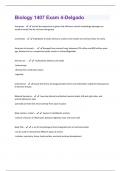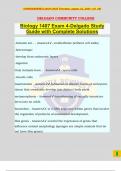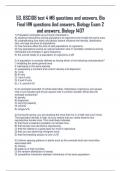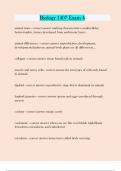Biology 1407 exam 4 - Study guides, Class notes & Summaries
Looking for the best study guides, study notes and summaries about Biology 1407 exam 4? On this page you'll find 4 study documents about Biology 1407 exam 4.
All 4 results
Sort by
Biology 1407 Exam 4 Questions and answers latest update

-
Biology 1407 Exam 4-Delgado Latest(2024/2025) Updated Questions and Answers with complete solutions.
- Exam (elaborations) • 8 pages • 2024
- Available in package deal
-
- $7.99
- + learn more
Hox genes - control the expression of genes that influence animal morphology (sponges are simple animals that do not have Hox genes) acoelmates - triploblastic animals without a coelom, their bodies are solid and have no cavity. Ancestors of animals... - diverged from ancient fungi, between 675 million and 800 million years ago, believed to be a suspension feeder similar to Choanoflagellates Animals are.. - -multicellular (without cell walls) -heterotropic -develop from embryonic layers ...

-
Biology 1407 Exam 4-Delgado Study Guide with Complete Solutions
- Exam (elaborations) • 11 pages • 2024
-
- $9.99
- + learn more
Biology 1407 Exam 4-Delgado Study Guide with Complete Solutions Animals are.. - Answer️️ --multicellular (without cell walls) -heterotropic -develop from embryonic layers -ingestive Only Animals have.. - Answer️️ --nerve cells -muscle cells Gastrulation - Answer️️ -formation of distinct layers of embryonic tissue that eventually develop into distinct body parts metamorphosis - Answer️️ -transforming of sexually immature larva into an adult homeobox - Answer️️ -is ...

-
Biology Exam 2 and answers
- Exam (elaborations) • 50 pages • 2024
- Available in package deal
-
- $30.48
- + learn more
53, BSC108 test 4 MB questions and answers, Bio Final HW questions And answers, Biology Exam 2 and answers, Biology 1407 1) Population ecologists are primarily interested in A) studying interactions among populations of organisms that inhabit the same area. B) understanding how biotic and abiotic factors influence the density, distribution, size, and age structure of populations. C) how humans affect the size of wild populations of organisms. D) how populations evolve as natural ...

Do you wonder why so many students wear nice clothes, have money to spare and enjoy tons of free time? Well, they sell on Stuvia! Imagine your study notes being downloaded a dozen times for $15 each. Every. Single. Day. Discover all about earning on Stuvia



